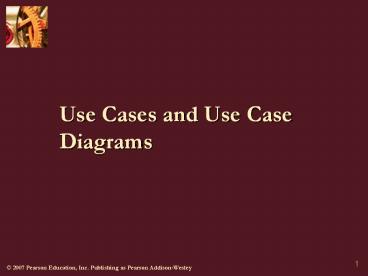Use Cases and Use Case Diagrams - PowerPoint PPT Presentation
1 / 20
Title:
Use Cases and Use Case Diagrams
Description:
To suggest processes for creating use case diagrams ... Insert another dollar for a deluxe wash.' Michael presses the button for an express wash. ... – PowerPoint PPT presentation
Number of Views:947
Avg rating:3.0/5.0
Title: Use Cases and Use Case Diagrams
1
Use Cases and Use Case Diagrams
2
Objectives
- To explain what use cases are
- To present UML use case diagram notation
- To suggest processes for creating use case
diagrams - To present rules and heuristics for making use
case diagrams. - To list use case diagram quality checks
- To explain when to use use case diagrams
3
Topics
- Why use case diagrams work
- Use cases, actors, and scenarios
- UML use case diagram notations
- How to make use case diagrams
- Rules of formation
- Heuristics
- Quality checks
- When to use use case diagrams
4
Why Use Case Modeling Works
- User-level requirements are generated from
stakeholder needs. - Operational-level requirements are hard to
generate in isolation. - Considering the interactions between a program
and its environment - Organizes operational level requirements
- Provides context for refinement
- Help avoid inconsistencies, omissions,
redundancies, etc.
5
Use Cases and Actors
A use case is a type of complete interaction
between and product and its environment. An
actor is a type of agent that interacts with a
product.
- The collection of use cases characterizes all
externally observable behavior. - A use case is an entire, coherent interaction.
- Actors are roles not individuals.
- The product is never an actor.
6
Use Case Diagrams
A use case diagram represents a products use
cases and the actors involved in each use case.
- Static model
- Catalog of all use cases
- UML diagram
7
Use Case Diagram Symbols
8
Use Case Diagram Example
- Use Case Diagram for an Automated Carwash
9
Scenarios
A scenario is an interaction between a product
and particular individuals.
- Instance of a use case
- Help envision how a product can be used
- Abstracted into use cases
10
A Scenario Example
Michael drives to the kiosk outside the carwash
and attempts to insert five dollars. The kiosk
accepts the money and displays the message You
have paid enough for a complete wash. Insert
another dollar for a deluxe wash. Michael
presses the button for an express wash. The kiosk
refunds one dollar. The carwash queries its stall
sensors. The stall sensors report that no car is
detected, so the kiosk displays the message
Please drive forward into the wash stall.
- Scenario for Buying a Car Wash
11
Making Use Case Diagrams 1
12
Making Use Case Diagrams 2
- An event list a list of all internal and external
events to which the product must respond. - Invent use cases to handle each event in the
list add it to the diagram - Consider each use case and determine its actors
add them to the diagram
13
Use Case Briefs
A use case or actor brief is a short description
of a use case or actor.
- Supplements the use case diagram
- Usually only one or tow sentences or phrases
14
Formation Rules
- Every use case diagram must have
- At least one use case
- At least one actor
- At least one actor associated with each use case
- At least one use case associated with each actor
- No association line between actors
- No association line between use cases
- Name every actor and use case
- Not label any association line
15
Use Case Diagram Heuristics 1
- Never make the product an actor.
- Name actors with noun phrases.
- Name use cases with verb phrases.
- Achieve a stakeholders goal in a use case.
- Make use cases that can be finished in a single
session.
16
Use Case Diagram Heuristics 2
- Make use cases of uniform size and complexity.
- Draw use case diagrams on one page.
- Organize use cases by actor, problem domain
categories, or solution categories.
17
Checking Use Case Diagrams 1
- Review the stakeholders-goals list to make sure
no actors are missing. - Review the needs list to make sure no uses cases
are missing. - Review constraints and limitations to make sure
they are no violated.
18
Checking Use Case Diagrams 2
- Generate an event list and check that all events
are handled. - Check that the collection of use cases covers all
externally visible behavior. - Check the diagram against the use case heuristics
above.
19
When to Use Use Case Diagrams
- User-level product design alternatives (more on
this later) - Summarizing design alternatives
- Catalog use cases elaborated in use cse
descriptions (more on this later) - A component of a use case model (more on this
later)
20
Summary
- Use cases are types of episodes of interaction
between a product and its environment. - Working with use cases help organize, analyze,
generate, evaluate, and select functional
requirements. - UML use case diagrams are static models of all
the use cases in a product. - There are several processes for creating use case
diagrams. - Rules govern use case diagram formation, and
heuristics and checks help achieve and ensure
their quality.































